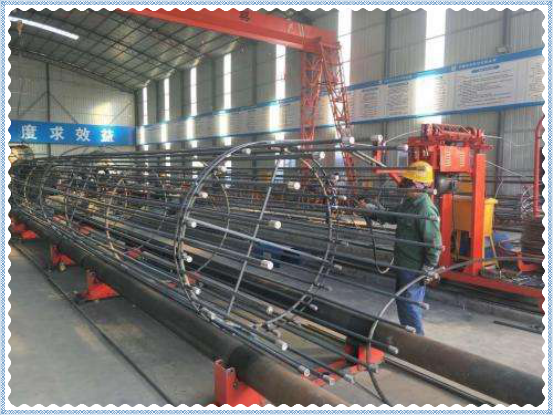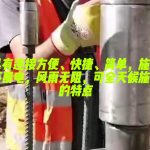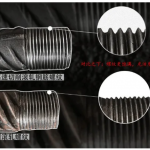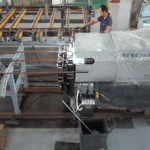Common application problems of reinforcement straight thread connection technology
The rib stripping and rolling straight thread connection technology of reinforcement was successfully developed by the construction mechanization research branch of China Academy of Building Sciences in 1999, and obtained one technical invention patent and two utility model patents. This technology has been widely applied to various reinforced concrete structures such as industrial and civil buildings, bridges, tunnels, subways, thermal power plants, hydropower stations and nuclear power plants, and can realize the same and different diameter connection of national standard reinforcement and British standard reinforcement in any direction and position from 12mm to 50mm. The joint performance shall meet the provisions of jgj107, bs8110 and other industrial standards (regulations). Because this technology has the advantages of high connection strength, stable and reliable quality, simple construction operation, low cost and so on, it is favored by the majority of users. In the process of wide popularization and application of this technology, some doubts and problems about joint construction acceptance often appear. This paper briefly expounds and explains it in combination with practical experience and understanding of industry standards for your reference.
Performance grade evaluation of grade I joint

Technical specification for mechanical connection of reinforcement jgj107-2016 is the latest industry standard for mechanical joints, which has been implemented since August 1, 2016. The original industry standard technical specification for mechanical connection of reinforcement jgj107-2010 is abolished at the same time. The new industry standard divides the performance grade of the joint into three performance grades I, II and III, and stipulates that the tensile strength of the grade I joint shall not be less than the actual tensile strength of the connected reinforcement or 1.1 times the standard value of the tensile strength of the reinforcement, and has high ductility and repeated tensile and compressive properties. During the tensile strength test of grade I joint in application, the following situations often occur: ① the joint failure occurs on the reinforcement base metal (i.e. the joint is broken from the base metal outside the connecting sleeve), but the tensile strength is lower than 1.1 times the standard value of reinforcement tensile strength; ② The failure position of the joint is not on the base metal of the reinforcement, but the reinforcement is pulled out of the sleeve or the sleeve is broken, or the joint is broken at the threaded part, but the tensile strength of the joint is not less than 1.1 times of the standard value of the tensile strength of the reinforcement.
When the above two test results appear, it is easy to doubt or even misjudge the evaluation of grade I joint. The reason for the misjudgment of case ① is that the standard is not fully understood or too much attention is paid to the tensile strength value of the joint. The interpretation of the provisions of the new standard explains the evaluation of grade I joint: during the construction site inspection and acceptance of the joint, as long as the test piece is broken from the reinforcement base metal, the joint can be determined as grade I. The tensile strength of the joint is higher than that of the reinforcement base metal as long as the joint can be broken in the reinforcement base metal during the tensile test; When the tensile strength of the joint is smaller than the standard tensile strength value of the reinforcement base metal, it can only indicate that there is a problem in the strength of the reinforcement base metal, which shall not affect the performance grade evaluation of the joint, and the tensile strength value of the joint shall no longer be used as the evaluation standard. The reason for the misjudgment of case ② is that the user pays too much attention to the failure position of the joint and always hopes that the failure form of all broken base metals can appear when the joint is subjected to unidirectional tensile test. When the joint specimen is broken in the joint length section, even if the tensile strength of the joint meets not less than 1.1 times of the standard value of tensile strength of reinforcement, many users still have doubts about whether the joint can be evaluated as grade I. According to the interpretation part of the new standard, the evaluation of grade I joint is as follows: when the test piece is broken in the joint length section, it can be determined as grade I joint as long as it meets not less than 1.1 times the standard value of tensile strength of reinforcement. In fact, the main reasons why the specimen is broken in the length section of the joint are as follows: ① the strength of the reinforcement used on site greatly exceeds the design strength of the connecting sleeve; ② In the process of on-site processing and connection construction, the quality control of wire head is not strict or the connection construction is not carried out according to the standard requirements; ③ There is a problem with the quality of the sleeve. If it belongs to case ①, the user shall accept it rationally; In case of cases ② and ③, the user shall, together with the product supplier, strive to strengthen the process management of production, procurement and other links to prevent the recurrence of such cases.
Thread exposure

The construction industry standard of the people’s Republic of China Technical Specification for mechanical connection of reinforcement jgj107-2016 stipulates that after the reinforcement is connected, the standard joint connecting sleeve shall have exposed effective threads, and the exposed effective threads on one side of the connecting sleeve shall not exceed 2p. In the actual construction, many construction personnel have doubts about the exposure of effective threads outside the standard joint connecting sleeve, and some simply require that effective threads are not allowed to be exposed. The main reasons for these doubts are: ① do not understand or fully understand the provisions of the industrial standard technical specification for mechanical connection of reinforcement jgj107-2016; ② Only pay attention to the tensile strength of the joint, ignoring the deformation performance requirements of the joint. At present, the rib stripping and rolling straight thread connection technology and products provided by most manufacturers in the market generally meet the requirements of industry standards as long as the effective thread screwing length is guaranteed. In fact, in addition to the strength requirements for reinforcement joints, there is also an important deformation index requirement. The deformation index of the joint during unidirectional tension is agreed in the standard term “joint inelastic deformation” in the industrial standard technical specification for mechanical connection of reinforcement jgj107-2016 of the people’s Republic of China, and the standard stipulates that this important deformation index can only be assessed during type inspection of the joint, There are no deformation assessment requirements during the tensile test of the joint for on-site construction inspection, and the absence of indicators requiring on-site assessment in the standard does not mean that it can be ignored. Imagine if the residual deformation beyond the concrete deformation occurs after the joint is subjected to a certain external force, whether there will be cracks or cracks affecting the structural quality, and serious safety and quality accidents will occur. Therefore, in order to ensure the joint connection strength and meet the requirements of joint deformation, it must be ensured that there shall be exposed effective threads outside the standard joint connection sleeve, and the exposed effective threads on one side of the connection sleeve shall not exceed 2p. The main reasons are: ① to ensure the connection strength of the joint, it is necessary to ensure the effective Screwing Length of the joint; ② Threaded connection belongs to clearance fit. In order to fully eliminate the thread clearance and ensure the deformation requirements, when the joint is tightened, only the exposed effective thread outside the sleeve can ensure the top tightening of the end face of the reinforcement, eliminate all kinds of interference and effectively eliminate the thread clearance without creating the illusion of tightening; ③ The exposed effective thread on one side of the connecting sleeve shall not exceed 2p. When the exposed thread exceeds 2p, the joint strength will be affected. Therefore, during the connection construction, it is very necessary to ensure that there are exposed effective threads outside the standard joint connecting sleeve, and the exposed effective threads on one side of the connecting sleeve shall not exceed 2p.
Butt joint of reinforcement cage

The traditional butt joint technology of reinforcement cage mainly includes lap binding method, welding method and sleeve extrusion connection method. Whether the butt joint of reinforcement cage can be realized by thread connection, especially by rib stripping and rolling straight thread connection technology, has always been concerned by the majority of construction technicians. In some projects, the rib stripping and rolling straight thread connection process is used to complete the butt connection of reinforcement cage. We find that the rib stripping and rolling straight thread connection process is not only feasible, but also economical and practical. The specific construction process is as follows.
Positive and negative wire butt connection

1) Manufacturing process flow of reinforcement cage: reinforcement blanking → process right-hand thread head and left-hand thread head respectively according to the reinforcement cage batching list (ensure that the thread head at one end of each reinforcement cage rotates in the same direction) → connect and fabricate the first section of reinforcement cage of the pile on the reinforcement cage fabrication tooling → connect the reinforcement of the second section of reinforcement cage that needs to be connected with the first section of reinforcement cage to the first section of reinforcement cage with positive and negative screw thread sleeve → weld the second section of reinforcement cage with annular stirrup → make obvious matching marks at the butt joint of a joint → multiple people rotate the positive and negative screw thread sleeve at the same time → after butt joint is completed Then disassemble the butted reinforcement cage from the butt joint. By analogy, other reinforcement cages shall be processed, and the reinforcement cages shall be placed in the reinforcement processing site or transported to the construction pile foundation for connection.
2) For the butt joint of reinforcement cages, the lowest section of prefabricated two or more reinforcement cages shall be hoisted into a certain depth of the pile hole for fixation
Firm → hoist another adjacent reinforcement cage to the joint → align the joint in sequence according to the pre-made marks → multiple people rotate the positive and negative screw thread sleeve at the same time to tighten the joint → loosen the fixed point of the reinforcement cage and hoist the connected reinforcement cage into the hole → connect and cut the reinforcement cage in sequence until the whole reinforcement cage is completed.
Filament butt connection

1) Fabrication process flow of reinforcement cage: reinforcement blanking → process standard thread head and standard long thread head respectively according to the reinforcement cage batching list → fabricate reinforcement cage on the reinforcement cage fabrication tooling (ensure that the reinforcement thread head in the next reinforcement cage at the butt joint of two or more reinforcement cages is filament) → connect the reinforcement of the second section of reinforcement cage to be connected with the first section with standard screw thread sleeve → weld the second section of reinforcement cage with annular stirrup → mark obvious matching marks at the butt joint of a joint → disassemble the butt joint → place the reinforcement cage in the reinforcement processing site or transport it to the construction pile foundation for connection.
2) For the butt joint of reinforcement cages, the lowest section of prefabricated two or more reinforcement cages shall be hoisted into the pile hole at a certain depth and fixed firmly → the adjacent reinforcement cage shall be hoisted to the joint → the joints shall be aligned in turn according to the marks → the sleeve on the next reinforcement cage shall be rotated out, Until the specified tightening torque value → loosen the fixing point of the reinforcement cage and hoist the connected reinforcement cage into the pile hole → connect to the pile hole in turn.
3.3 precautions when two or more reinforcement cages need to be butted, effective anti deformation measures shall be taken during lifting, transportation and installation of reinforcement cages to ensure that the deformation of reinforcement cages will not affect the construction of butt joint. The lifting point should be set at the reinforced stirrup, and the spacing between adjacent joints on the same bottom surface of the reinforcement cage should not be less than 50 m.
5 Conclusion
The technology of rib stripping and rolling straight thread connection of reinforcement has been popularized and applied in the construction market for more than ten years. At present, it is spread all over the country. The application field is extended to all kinds of reinforced concrete structures and has entered the international market. The technology has experienced a process from being questioned to being generally accepted by the majority of owners, design units, construction enterprises and supervision units, and then favored by the majority of users until today’s vigorous development. With the continuous emergence and solution of various new problems in the process of engineering application, its application field will be gradually expanded, and the social and economic benefits will be increased day by day.
 五隆兴科技发展有限公司
五隆兴科技发展有限公司




